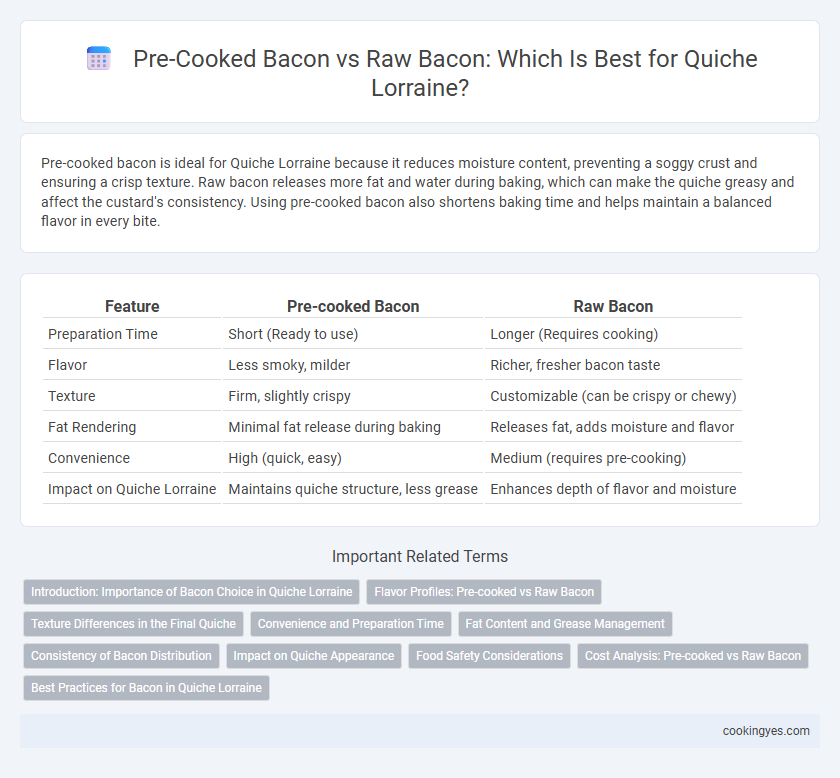Pre-cooked bacon is ideal for Quiche Lorraine because it reduces moisture content, preventing a soggy crust and ensuring a crisp texture. Raw bacon releases more fat and water during baking, which can make the quiche greasy and affect the custard's consistency. Using pre-cooked bacon also shortens baking time and helps maintain a balanced flavor in every bite.
Table of Comparison
| Feature | Pre-cooked Bacon | Raw Bacon |
|---|---|---|
| Preparation Time | Short (Ready to use) | Longer (Requires cooking) |
| Flavor | Less smoky, milder | Richer, fresher bacon taste |
| Texture | Firm, slightly crispy | Customizable (can be crispy or chewy) |
| Fat Rendering | Minimal fat release during baking | Releases fat, adds moisture and flavor |
| Convenience | High (quick, easy) | Medium (requires pre-cooking) |
| Impact on Quiche Lorraine | Maintains quiche structure, less grease | Enhances depth of flavor and moisture |
Introduction: Importance of Bacon Choice in Quiche Lorraine
Selecting the right bacon is crucial for an authentic Quiche Lorraine, as its texture and flavor significantly influence the dish's overall quality. Pre-cooked bacon offers convenience and a consistent crispiness, while raw bacon imparts a richer, more robust taste when properly rendered during baking. Understanding these differences ensures a perfectly balanced quiche with the ideal smoky depth and mouthfeel.
Flavor Profiles: Pre-cooked vs Raw Bacon
Pre-cooked bacon in Quiche Lorraine offers a consistently smoky and crispy texture, enhancing the quiche's savory depth without releasing excess grease. Raw bacon, when cooked within the quiche, imparts a richer, more pronounced pork flavor and renders fat that infuses the custard with moistness and complexity. Choosing between pre-cooked and raw bacon ultimately influences the quiche's balance of texture and intensified bacon aroma.
Texture Differences in the Final Quiche
Pre-cooked bacon in Quiche Lorraine yields a crisp, evenly textured filling, preventing sogginess by releasing rendered fat before baking. Raw bacon imparts a chewier, slightly fattier bite, as it cooks slowly within the custard, affecting the quiche's overall moisture and texture profile. Choosing pre-cooked bacon enhances structural integrity, while raw bacon offers richer, more varied mouthfeel in the final dish.
Convenience and Preparation Time
Pre-cooked bacon significantly reduces preparation time for Quiche Lorraine by eliminating the need for extra cooking steps, allowing for immediate incorporation into the recipe. Using pre-cooked bacon offers greater convenience, as it can be chopped and added directly to the egg custard mixture without additional frying or draining. In contrast, raw bacon requires careful cooking and crisping prior to assembly, increasing both hands-on time and kitchen cleanup effort.
Fat Content and Grease Management
Pre-cooked bacon for quiche Lorraine offers a more controlled fat content, reducing excess grease in the filling and preventing a soggy crust. Raw bacon releases more fat during cooking, which can make the quiche richer but requires careful grease management to avoid an overly oily texture. Selecting pre-cooked bacon enhances flavor consistency while balancing the quiche's overall moisture levels.
Consistency of Bacon Distribution
Pre-cooked bacon ensures a more consistent distribution throughout Quiche Lorraine by maintaining its shape and preventing excess grease from pooling in the custard. Raw bacon can release uneven amounts of fat during baking, causing soggy spots and irregular texture. Using pre-cooked bacon improves the quiche's structural integrity and enhances overall flavor balance.
Impact on Quiche Appearance
Using pre-cooked bacon in Quiche Lorraine results in a more uniform and crisp appearance, preventing excess grease from pooling and causing sogginess. Raw bacon renders its fat during baking, which can create uneven browning and greasy patches on the quiche surface. Selecting pre-cooked bacon enhances the visual appeal by maintaining a consistent, golden-brown texture without compromising the quiche's delicate custard.
Food Safety Considerations
Using pre-cooked bacon in Quiche Lorraine reduces the risk of foodborne illness by ensuring the pork has reached a safe internal temperature before baking. Raw bacon requires thorough cooking within the quiche to eliminate pathogens like Salmonella and Listeria, which can pose health hazards. Proper handling and cooking times must be observed to maintain food safety when incorporating raw bacon into the dish.
Cost Analysis: Pre-cooked vs Raw Bacon
Pre-cooked bacon for quiche Lorraine typically costs more upfront due to processing but reduces cooking time and waste, potentially lowering overall kitchen expenses. Raw bacon, often cheaper per pound, requires additional preparation time and can lead to variable fat rendering, affecting the quiche's texture and cost efficiency. Budget-conscious cooks may prefer raw bacon for its lower initial price, while commercial kitchens often favor pre-cooked bacon to streamline operations despite the higher unit cost.
Best Practices for Bacon in Quiche Lorraine
Using pre-cooked bacon in Quiche Lorraine helps maintain a crisp texture and prevents excess grease from making the quiche soggy, ensuring a balanced flavor and consistency. Raw bacon offers richer flavor integration but requires careful frying to render fat without overcooking, which can affect the quiche's moisture. Best practices recommend partially cooking raw bacon to crispy but not fully done before adding to the custard, achieving optimal taste and texture in traditional Quiche Lorraine.
Pre-cooked bacon vs raw bacon for quiche Lorraine Infographic

 cookingyes.com
cookingyes.com